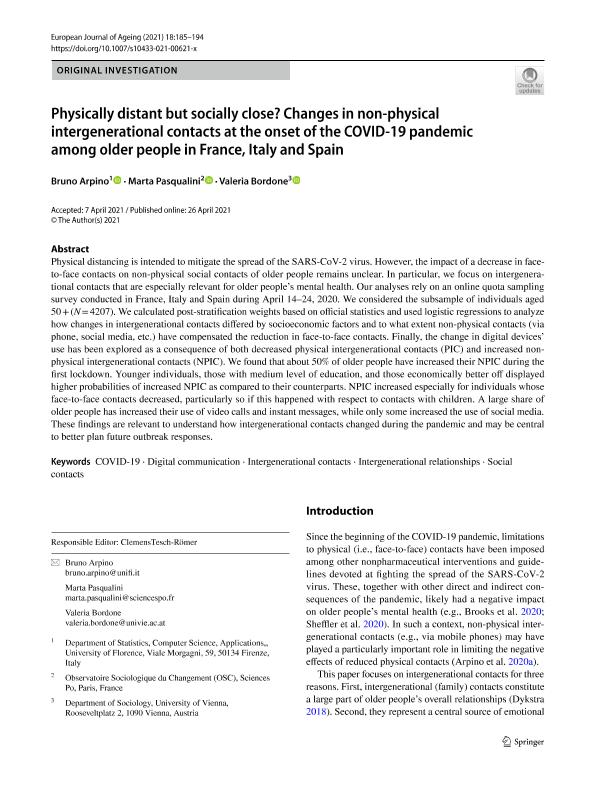| LDR | | | 00000cab a2200000 4500 |
| 001 | | | MAP20210024245 |
| 003 | | | MAP |
| 005 | | | 20210722105452.0 |
| 008 | | | 210722e20210614che|||p |0|||b|eng d |
| 040 | | | $aMAP$bspa$dMAP |
| 084 | | | $a931.2 |
| 100 | 1 | | $0MAPA20210029936$aArpino, Bruno |
| 245 | 1 | 0 | $aPhysically distant but socially close? Changes in non-physical intergenerational contacts at the onset of the COVID-19 pandemic among older people in France, Italy and Spain$cBruno Arpino, Marta Pasqualini, Valeria Bordone |
| 520 | | | $aPhysical distancing is intended to mitigate the spread of the SARS-CoV-2 virus. However, the impact of a decrease in face-to-face contacts on non-physical social contacts of older people remains unclear. In particular, we focus on intergenerational contacts that are especially relevant for older people's mental health. Our analyses rely on an online quota sampling survey conducted in France, Italy and Spain during April 1424, 2020. We considered the subsample of individuals aged 50?+?(N?=?4207). We calculated post-stratification weights based on official statistics and used logistic regressions to analyze how changes in intergenerational contacts differed by socioeconomic factors and to what extent non-physical contacts (via phone, social media, etc.) have compensated the reduction in face-to-face contacts. Finally, the change in digital devices' use has been explored as a consequence of both decreased physical intergenerational contacts (PIC) and increased non-physical intergenerational contacts (NPIC). We found that about 50% of older people have increased their NPIC during the first lockdown. Younger individuals, those with medium level of education, and those economically better off displayed higher probabilities of increased NPIC as compared to their counterparts. NPIC increased especially for individuals whose face-to-face contacts decreased, particularly so if this happened with respect to contacts with children. A large share of older people has increased their use of video calls and instant messages, while only some increased the use of social media. These findings are relevant to understand how intergenerational contacts changed during the pandemic and may be central to better plan future outbreak responses.
|
| 540 | | | $aLa copia digital se distribuye bajo licencia "Attribution 4.0 International (CC BY 4.0)"$f$uhttps://creativecommons.org/licenses/by/4.0$943 |
| 650 | | 4 | $0MAPA20200021438$aAgeingnomics. Economia senior |
| 650 | | 4 | $0MAPA20200005599$aCOVID-19 |
| 650 | | 4 | $0MAPA20090015944$aDistancia de seguridad |
| 651 | | 1 | $0MAPA20080637767$aItalia |
| 651 | | 1 | $0MAPA20080637880$aFrancia |
| 651 | | 1 | $0MAPA20080637736$aEspaña |
| 700 | 1 | | $0MAPA20210029943$aPasqualini, Marta |
| 700 | 1 | | $0MAPA20210029950$aBordone, Valeria |
| 773 | 0 | | $wMAP20210024146$tEuropean Journal of Ageing : social, behavioural and health perspectives$dCham, Switzerland [etc.] : Springer International Publishing AG, 2021-$g14/06/2021 Volumen 18 Número 2 - 2021 , p. 185-194 |
| 856 | | | $qapplication/pdf$w1112793$yRecurso electrónico / Electronic resource |


